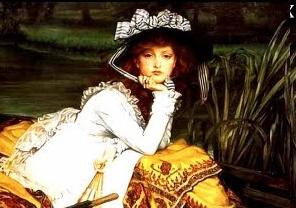With the great variety of shows centred around looking into the homes of others, Holmes on Homes, Trading Spaces, Divine Design and House Hunters International, my favorite, there is also, thankfully, a lot of classical literature that centre’s on the magnificent homes of others. Sometimes I do find myself picking up a book solely because the cover portrays a magnificent estate and I know when I read the story, I will be transported to elegance I can only read about.
This is why I have decided to list my top 5 books with big houses:
1. The Great Gatsby by F. Scott Fitzgerald
 “I believe that on the first night I went to Gatsby’s house I was one of the few guests who had actually been invited. People were not invited–they went there.”
“I believe that on the first night I went to Gatsby’s house I was one of the few guests who had actually been invited. People were not invited–they went there.”
– In my mind I see Gatby’s house as a neo-classical example of architecture in the 1920’s. Click here to get more of a feel for what it would have been furnished with.
*
*
*
2. The Mysteries of Udolpho by Ann Radcliffe
 “All without was silent and dark, unless that could be called light, which was only the faint glimmer of the stars, showing imperfectly the outline of the mountains, the western towers of the castle, and the ramparts below where a solitary sentinel was pacing. What an image of repose did this scene present! …in a foreign land – in a remote castle – surrounded by vice and violence…” (Page 97).
“All without was silent and dark, unless that could be called light, which was only the faint glimmer of the stars, showing imperfectly the outline of the mountains, the western towers of the castle, and the ramparts below where a solitary sentinel was pacing. What an image of repose did this scene present! …in a foreign land – in a remote castle – surrounded by vice and violence…” (Page 97).
– The Castle of Otranto from the novel is a medieval castle and is todays definition of gothic in literature. The house is made to have a spirit of it’s own and a history that surpasses all who live there.
*
3. The Female Quixote or The Adventures of Arabella by Charlotte Lennox

“The Marquis, following the Plan of Life he has laid down, divided his Time between the Company of his Lady, his Liberty, which was large and well furnished, and his Gardens.” (Page 6).
– This novel is an example of the Romantic Period and includes much grander descriptions of homes than the one I was able to find above. The main character Arabella lives like Don Quixoto, having read too many romances, and believes the world to be but a fairy tale.
*
4. Dracula by Bram Stoker
 “The castle was built on the corner of a great rock, so that on three sides it was quite impregnable, and great windows were placed here…The windows now curtainless, and the yellow moonlight, flooding in thorugh the diamond panes, enabled one to see even colours, whilst it softended a wealth of dust which lay over all and disguised in some measure the ravages of time and moth.” (Page 55-6).
“The castle was built on the corner of a great rock, so that on three sides it was quite impregnable, and great windows were placed here…The windows now curtainless, and the yellow moonlight, flooding in thorugh the diamond panes, enabled one to see even colours, whilst it softended a wealth of dust which lay over all and disguised in some measure the ravages of time and moth.” (Page 55-6).
– Stoker describes Dracula’s castle in great detail, perhaps because he was inspired when visiting this real-life castle in Transylvania. This 700-year-old castle thankfully haunted Stoker’s mind and the result, one of the most popular gothic tales of all time.
*
And for the finale…
5. Against Nature (À rebours) by J.K. Huysmans

“This dining-room resembled a ship’s cabin, with its ceiling of arched beams, its bulkheads and floorboards of pitch-pine, and the little window-opening let into the wainscoting like a porthole. (page 19). …By these means he was able to enjoy quickly, almost simultaneously, all the sensations of a long sea-voyage, without ever leaving home;” (page 21).
– I recommend anyone who is in design to seriously think of reading this. The main character Jean Des Esseintes is a rich man in Paris who shuts himself away in his house, which mimics many different atmospheres, such as the description of traveling on a ship above. The novel is titled Against Nature because Esseintes mimics nature, fooling his senses to think he is exerperiencing something authentic. I would love to see someone design the home he describes, because it really is a masterpiece.
*
Any recommendations?






![]()
![]()
![]()
![]()









 When I read this book I did feel the same, slightly tormented, but I would describe it more as an unease. With a lot of religious overtones (and undertones of Atheism), it does feel ‘preachy’ at times. However, this is always interrupted with an unknown devil-like character that causes all the trouble in the novel.
When I read this book I did feel the same, slightly tormented, but I would describe it more as an unease. With a lot of religious overtones (and undertones of Atheism), it does feel ‘preachy’ at times. However, this is always interrupted with an unknown devil-like character that causes all the trouble in the novel. “I believe that on the first night I went to Gatsby’s house I was one of the few guests who had actually been invited. People were not invited–they went there.”
“I believe that on the first night I went to Gatsby’s house I was one of the few guests who had actually been invited. People were not invited–they went there.” “All without was silent and dark, unless that could be called light, which was only the faint glimmer of the stars, showing imperfectly the outline of the mountains, the western towers of the castle, and the ramparts below where a solitary sentinel was pacing. What an image of repose did this scene present! …in a foreign land – in a remote castle – surrounded by vice and violence…” (Page 97).
“All without was silent and dark, unless that could be called light, which was only the faint glimmer of the stars, showing imperfectly the outline of the mountains, the western towers of the castle, and the ramparts below where a solitary sentinel was pacing. What an image of repose did this scene present! …in a foreign land – in a remote castle – surrounded by vice and violence…” (Page 97).
 “The castle was built on the corner of a great rock, so that on three sides it was quite impregnable, and great windows were placed here…The windows now curtainless, and the yellow moonlight, flooding in thorugh the diamond panes, enabled one to see even colours, whilst it softended a wealth of dust which lay over all and disguised in some measure the ravages of time and moth.” (Page 55-6).
“The castle was built on the corner of a great rock, so that on three sides it was quite impregnable, and great windows were placed here…The windows now curtainless, and the yellow moonlight, flooding in thorugh the diamond panes, enabled one to see even colours, whilst it softended a wealth of dust which lay over all and disguised in some measure the ravages of time and moth.” (Page 55-6).